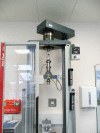Biomechanical Properties of First Dorsal Extensor Compartment Regarding Adequacy as a Bone-Ligament-Bone Graft
- PMID: 28831343
- PMCID: PMC5548566
- DOI: 10.1097/GOX.0000000000001397
Biomechanical Properties of First Dorsal Extensor Compartment Regarding Adequacy as a Bone-Ligament-Bone Graft
Abstract
Bone-ligament-bone grafts for reconstruction of the scapholunate ligament are a valuable tool to prevent disease progression to carpal collapse. Locally available grafts do not require an additional donor site. The first extensor compartment was evaluated biomechanically regarding its possible use as an autograft.
Methods: Twelve native fresh-frozen, human cadaver specimens were tested by applying axial tension in a Zwick Roell machine. Load to failure, transplant elongation, and bony avulsion were recorded. The load to failure was quantitated in newtons (N) and the displacement in length (millimeters). Parameters were set at distinct points as start of tension, 1 mm stretch and 1.5 mm dissociation, failure and complete tear, and were evaluated under magnified visual control. Although actual failure occurred at higher tension, functional failure was defined at a stretch of 1.5 mm.
Results: Mean load at 1 mm elongation was 44.1 ± 28 N and at 1.5 mm elongation 57.5 ± 42 N. Failure occurred at 111 ± 83.1 N. No avulsion of the bony insertion was observed. Half the transplants failed in the central part of the ligament, while the rest failed near the insertion but not at the insertion itself. Analysis of tension strength displayed a wide range from 3.8 to 83.7 N/mm at a mean of 33.4 ± 28.4 N/mm.
Conclusions: The biomechanical tensile properties of the first dorsal extensor compartment are similar to those of the dorsal part of the scapholunate ligament. A transplant with a larger bone stock and a longer ligament may display an advantage, as insertion is possible in the dorsal, easily accessible part of the carpal bones rather than in the arête-like region adjacent to the insertion of the scapholunate ligament. In this study, 1.5 mm lengthening of the bone-ligament-bone transplant was defined as clinical failure, as such elongation will cause severe gapping and is considered as failure of the transplant.
Conflict of interest statement
Disclosure: Supported by the German Research Foundation (Deutsche Forschungsgemeinschaft) and the University of Wuerzburg in the funding program Open Access Publishing. The Article Processing Charge was paid for by German Research Foundation (Deutsche Forschungsgemeinschaft) and the University of Wuerzburg in the funding program Open Access Publishing.
Figures







References
-
- Mayfield J. Wrist ligamentous anatomy and pathogenesis of carpal instability. Orthop Clin. 1984; 15:209–216.. - PubMed
-
- Lavernia CJ, Cohen MS, Taleisnik J. Treatment of scapholunate dissociation by ligamentous repair and capsulodesis. J Hand Surg Am. 1992;17:354–359.. - PubMed
-
- Cohen MS, Taleisnik J. Direct ligamentous repair of scapholunate dissociation with capsulodesis augmentation. Tech Hand Up Extrem Surg. 1998;2:18–24.. - PubMed
-
- Almquist EE, Bach AW, Sack JT, et al. Four-bone ligament reconstruction for treatment of chronic complete scapholunate separation. J Hand Surg Am. 1991;16:322–327.. - PubMed
-
- Brunelli GA, Brunelli GR. A new technique to correct carpal instability with scaphoid rotary subluxation: a preliminary report. J Hand Surg Am. 1995;20:S82–S85.. - PubMed
LinkOut - more resources
Full Text Sources
Other Literature Sources
